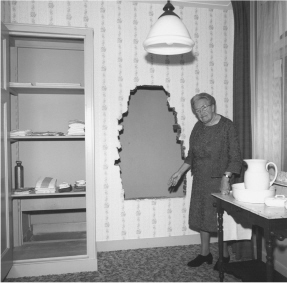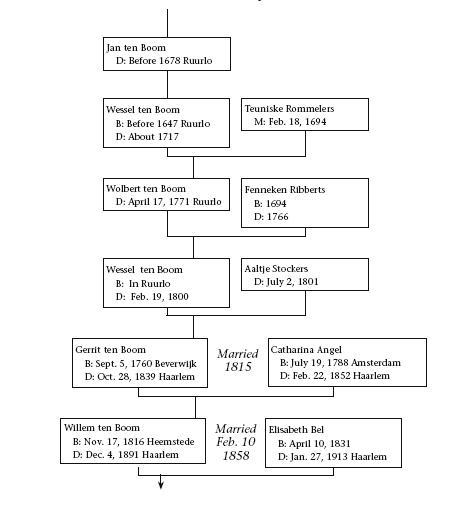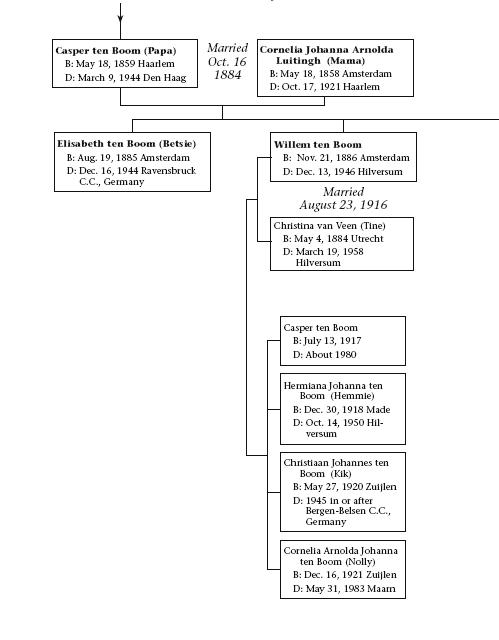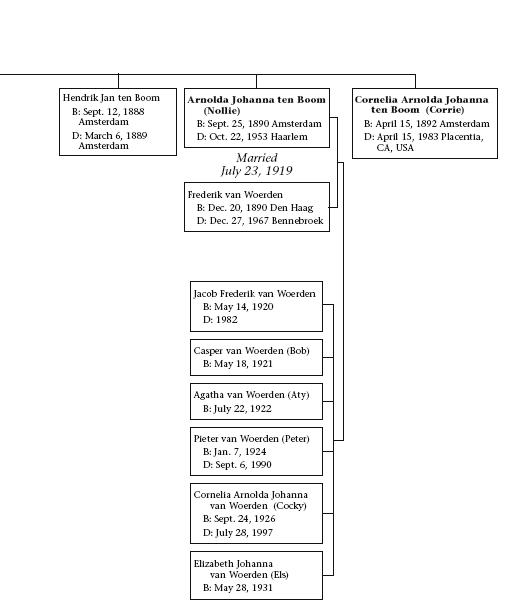The Hiding Place (35 page)
At 11:00 at night on her ninety-first birthdayâApril 15, 1983â Corrie, in the phrase she had always used, “went home” at last.
For readers of
Guideposts
who had followed Corrie's adventures, and for myself most of all, I wrote down my reaction to the news of her death:
I tried to be glad for Corrie when the phone call came from California: she'd waited for her “homecoming” so long. But death, from the perspective of earth, means saying good-bye. Feeling my loss, I roamed our house, touching one by one the physical objects she'd given us over the years. An antique brass kettle. A small square picture frame. An even smaller round one.
Little things that recalled big truths our friend shared. . . .
The kettle spoke to me about priorities. It was Betsie who'd spied it, dented and soot-encrusted, in a junkyard one morning on her way to the market. She bought it with the meat money.
“Betsie!” cried Corrie, coming upstairs from the watch shop. “What are we going to do with that old thing? Look, it won't even hold water!”
“It's not
meant
to hold water,” Betsie replied with dignity.
“Well, what's it for, then?”
“It's not âfor' anything. Oh, Corrie, wait till I get the grime off! Can't you just see the morning sun glowing on this spout?
“I got stew meat instead of a roast,” she hurried on. “You know stew is really easier for Father to chew, and I'm not hungry today. Oh, Corrie, this kettle will go on shining long after we've forgotten what we had for dinner tonight!”
And so it did. It shone for the hunted people who found shelter in the Beje. It shone for Corrie when she returned there alone from the concentration camp, and from her tireless trips to Russia, China, Vietnam. It shines in our home today, saying, What feeds the soul matters as much as what feeds the body.
In the square frame is a piece of yellow cloth cut in the shape of a six-pointed star. Across the star are four black letters: jood, the Dutch word for
Jew
. When I was in Holland researching Corrie's story, she took me to the home of Meyer Mosselâ“Eusebius” during the Nazi occupation. We sipped tea while Corrie and Eusie reminisced.
“You'd take your pipe with you,” Corrie reminded him, recalling the practice drills, “but you'd forget your ashtray, and I'd have to come running after you.”
Eusie set down his cup and crossed the room to a massive antique sideboard. From the bottom drawer, buried beneath a pile of table linen, he drew out a scrap of yellow cloth cut in the shape of a star.
“All these years I wondered why I saved this thing,” he said. “Now I know it was to give to you, Corrie.”
We picked out the frame for Eusie's star that very afternoon. For years it hung on Corrie's wall as it hangs now on oursâa symbol bittersweet as a cross. To me the star says, Whatever in our life is hardest to bear, love can transform into beauty.
And the little round frame? It holds a piece of cloth, tooâordinary white cotton, the kind underwear is made of. In fact, it
is
underwear, a fragment of the undershirt Corrie was wearing when the Gestapo raid came.
In solitary confinement in the prison at Scheveningen, the first place she was taken after her arrest, idleness was eroding Corrie's courage. Nollie smuggled a needle and thread to her, but soon the thread was used up. Then Corrie remembered the undershirt. She unraveled a hem. And now! Animals, houses, facesâshe covered the undershirt with embroidery.
The design in the round frame is a flower, with elegant curling edges and six leaves on a graceful stem. You have to look closely to see the flower (the thread, of course, is the same color as the cloth). And underwearâeven a dear friend'sâwell, it isn't the most costly of the things Corrie gave us. But it was the one that spoke most clearly now that she was gone.
The circle of white cotton told me that when we're feeling poorestâ when we've lost a friend, when a dream has failed, when we seem to have nothing left in the world to make life beautifulâthat's when God says,
You're richer than you think.
Elizabeth Sherrill
Chappaqua, New York
September 2005

For a short time in the 1970s, Corrie's home in Haarlem, Holland, was open as a museum. In this photo, Corrie stands in front of the hiding place. The hole in the bricks is for visitors to see inside the hiding place more easily. The original entrance is through the bottom of the closet. Since 1988, the Corrie ten Boom House is once again an inspiring museum.
APPENDIX
Ten Boom Family Resources and Timeline
of Corrie ten Boom's Life
C
hosen Books is indebted to researcher and author Emily S. Smith for the following timeline of the Ten Boom family and their family tree. These resources enable the reader to trace many of Corrie's family relationships; to place various members of the family, including the dates of their births and deaths; and to follow the timing of events in Corrie's life and travels in considerable detail.
This timeline and family tree appear in the book entitled
A Visit
to the Hiding Place: The Life-Changing Experiences of Corrie ten Boom
, written by Emily S. Smith and published by the Corrie ten Boom House Foundation in Haarlem, the Netherlands. Our warmest thanks to Emily and to Frits Nieuwstraten, director of the Foundation, for granting us permission to reproduce these invaluable pieces of work. (This permission covers use in all languages and all editions throughout the world.)
The Beje, the Ten Booms' home that contains the hiding place, is now a museumâthe Corrie ten Boom House.
The Ten Boom Family

All locations in the Netherlands, unless noted. Van Woerden information verified by Inge van Woerden. Other information provided by Hendrik ten Boom, Chief of Archives, Rotterdam (nephew of Casper).


Ten Boom Family Timeline
T
his timeline contains many highlights in the Ten Boom family's life and in Corrie's ministry.
1837
Willem ten Boom (Corrie's grandfather) rents shop space and opens Ten Boom Horlogerie (watch shop) at Barteljorisstraat 19, Haarlem. In 1849, he is able to purchase the house for 1,200 guilders (FtB 27).
1841
Willem marries Geertruida van Gogh. They have thirteen children, but eight die before age four.
1844
Willem begins a prayer group to “pray for the peace of Jerusalem” (FH 15).
1856
Geertruida dies of tuberculosis at age 42 (FtB 26).
1858
Willem marries Elisabeth Bel February 10. They have six children; two die very young.
1859
Casper ten Boom (Corrie's father, the oldest of Elisabeth's children) is born May 18.
1884
Casper and Cornelia (Cor) Luitingh wed October 16. They reside at 28 Korte Prinsengracht, Amsterdam.
1885
Elisabeth (Betsie) is born August 19. Tante (Aunt) Anna (Cor's sister) comes to live with the family.
1886
Willem is born November 21.
1888
Hendrik Jan is born September 12 but dies March 6, 1889.
1890
Arnolda Johanna (Nollie) is born September 25. Ten Booms move to another house in Amsterdam (FtB 47).
1891
Grandfather Willem dies December 4, age 75.
1892
Cornelia Arnolda Johanna (Corrie) is born April 15 on Good Friday, about one month premature. Casper and family move from Amsterdam to a rented house in Haarlem so he can work in Ten Boom Horlogerie (FtB 52-53). Corrie is christened in the Dutch Reformed Church in July (PerL).
(From this point on, Corrie's age appears
in brackets after the year. Corrie's
birthday is April 15. The age listed
for each year is her age following her
birthday.)
1895 [3]
Tante Jans (Cor's sister) comes to live with the Ten Booms.
1897 [5]
Elisabeth (Casper's mother) moves from Barteljorisstraat 19, and Casper and family move in. Casper has house remodeled (FtB 55). Corrie prays and gives her life to Jesus (FH 24).
1909 [17]
Papa and Mama celebrate their 25th wedding anniversary. Corrie has completed primary and secondary school and studies at Domestic Science School (FtB 94). Ten Booms begin a missions study group in their home.
1910 [18]
Corrie takes classes at a Bible school in Haarlem for two years. She fails her final exam but receives her diploma eight years later (FH 93â94).
1911 [19]
Corrie works as an au pair (governess). Tante Bep (Cor's sister, who also lived with the Ten Booms) dies of tuberculosis at age 70. Corrie returns home (FH 75). Mama has slight stroke (FH 93).
1914 [22]
World War I begins. Corrie has appendectomy following months of bed rest (PerL).
1916 [24]
Willem is ordained. He is called to a church in Made; the family attends his first sermon. In Made, Corrie's friend Karel (not his real name) talks with her about their future together. They see each other again when Willem marries Tine van Veen August 23. In November, Corrie's heart is broken when Karel introduces her to his fiancée (HP 59â60). Willem pastors in Made four years, then in Zuijlen until 1926.
1918 [26]
Mama has major stroke (HP 62â63). As World War I ends, Ten Booms take in Willy, Katy, and Mrs. Treckmann and her children Ruth and Martha, all from Germany (FH 102â4).
1919 [27]
Tante Jans dies from diabetes at age 71. Nollie marries Frederik “Flip” van Woerden July 23.
1920 [28]
Corrie completes her watchmaking apprenticeship in two factories in Switzerland (PerL).
1921 [29]
Mama dies October 17 at age 63. Corrie works in clock shop full-time; Betsie takes over housekeeping (FH 113).
1924 [32]
Corrie becomes Holland's first licensed woman watchmaker (HP 69).
1925 [33]
Tante Anna dies March 7 at age 64. Ten Booms begin to take in missionary children, three of them from one family: Puck, Hans, Hardy (FH 133), Lessie (FH134), Miep (FH 137), and Marijke (FH 140). In 1925, there are seven foster children total, known as the Red Cap Club. Corrie starts Christian girls' clubs; she works with them until 1940, when the Nazis order no group meetings (FH 125â82).